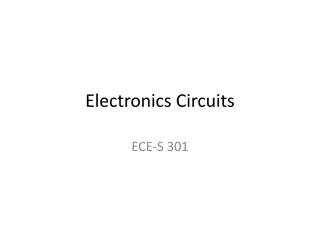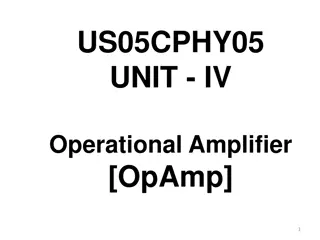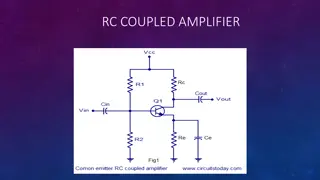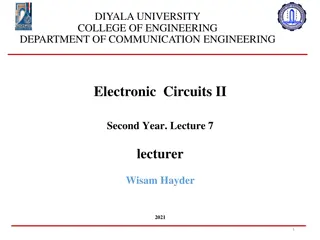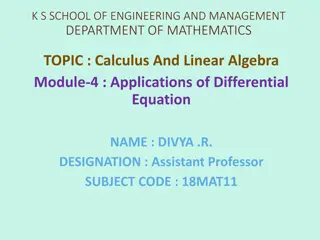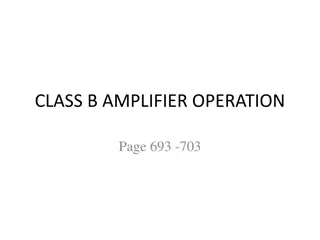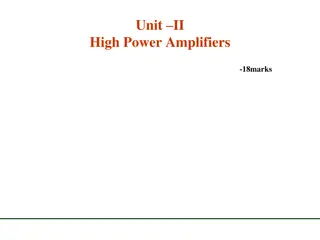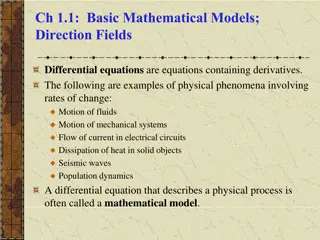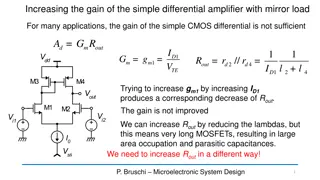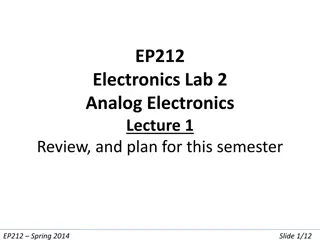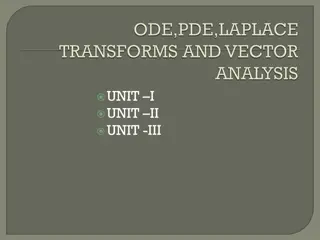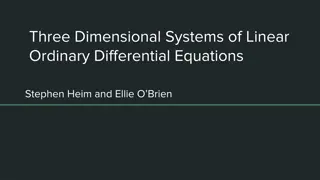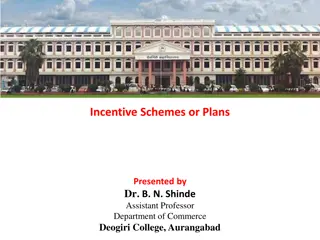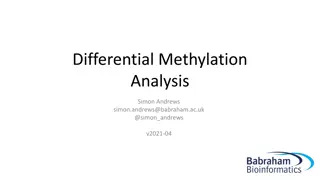Understanding CMRR in Differential Amplifiers
Differential input amplifiers, including operational, instrumentation, and difference amplifiers, play a crucial role in amplifying differential signals while rejecting common-mode noise. The Common-Mode Rejection Ratio (CMRR) is a key parameter in these amplifiers, indicating their ability to suppress common-mode signals. Learn about CMRR definitions, common-mode voltage, and ideal characteristics of differential amplifiers through this comprehensive guide.
- Differential Amplifiers
- CMRR
- Common-Mode Rejection Ratio
- Operational Amplifiers
- Instrumentation Amplifiers
Download Presentation

Please find below an Image/Link to download the presentation.
The content on the website is provided AS IS for your information and personal use only. It may not be sold, licensed, or shared on other websites without obtaining consent from the author. Download presentation by click this link. If you encounter any issues during the download, it is possible that the publisher has removed the file from their server.
E N D
Presentation Transcript
Fully Understanding CMRR in DAs, IAs, and OAs 1
Outline Definitions Differential-input amplifier Common-mode voltage Common-mode rejection ratio (CMRR) Common-mode rejection (CMR) CMRR in Operational Amplifiers CMRR in Difference Amplifiers CMRR in Instrumentation Amplifiers CMRR in Hybrid Amplifiers 2
Differential Input Amplifier Differential input amplifiers are devices/circuits that can input and amplify differential signals while suppressing common-mode signals This includes operational amplifiers, instrumentation amplifiers, and difference amplifiers Instrumentation Amplifiers Operational Amplifier Difference Amplifier 3
Common-Mode Voltage For a differential input amplifier, common-mode voltage is defined as the average of the two input voltages. [2] Vp+Vn Vcm= 2 - + + Vo + + - Vn Vp 4
Common-Mode Voltage (Alternate defn.) For a differential amplifier, common-mode voltage is defined as the average of the two input voltages. [2] IOP1 - - Vid + + + Vout - Vp+Vn ( ) ( ) = + V A V A V Vcm= Vid/2 Vid/2 out dm id cm cm 2 where A where Vid = Differenti al - mode gain Vp=Vcm+ dm Vcm 2 = Common - mode gain A Vid cm Vn=Vcm- 2 5
Common-Mode Voltage Ideally a differential input amplifier only responds to a differential input voltage, not a common-mode voltage. V+ V- OP1 4 2 Vs+ 5 - V- 6 - Vid ++ 7 OP1 1000uV 3 4 + 2 - + 6 Vo 3.826745V - Vs- 5 - Vid ++ 7 0V 3 + V+ + Vo 0V - Va 1m V- Vb 0 V+ Va 0 Vb 0 V- Vcm 1 OP1 4 2 - Vcm 0 6 - Vid ++ 7 0V 3 + + Vo 0V - V+ Va 0 Vb 0 Vcm 1 6
CMRR and CMR Common-Mode Rejection Ratio is defined as the ratio of the differential gain to the common-mode gain A CMRR = dm A cm CMR is defined as follows [2]: ( ) ( ) = 20 log CMR dB CMRR 10 CMR and CMRR are often used interchangeably 7
Ideal Differential Amplifier CMRR What is the CMRR of an ideal differential input amplifier (e.g. op-amp)? Recall that the ideal common-mode gain of a differential input amplifier is 0. Voltage Amplifier Model [1] Amplifier Source Load Ro Rs VCVS + + + + Vs Vi Ri Vi Vo Rload - - - - Adm->Infinity Also recall the differential gain of an ideal op-amp is infinity. A A So = = dm dm CMRR ideal OA A A cm cm 8
Real Op-Amp CMRR In an operational amplifier, the differential gain is known as the open- loop gain. The open-loop gain of an operational amplifier is fixed and determined by its design 9
Real Op-Amp CMRR However, there will be a common-mode gain due to the following Asymmetry in the circuit Mismatched source and drain resistors Signal source resistances Gate-drain capacitances Forward transconductances Gate leakage currents Output impedance of the tail current source Changes with frequency due to tail current source s shunt capacitance These issues will manifest themselves through converting common- mode variations to differential components at the output and variation of the output common-mode level. [4] 10
Resistor Mismatch Let s look at the case of a slight mismatch in drain resistances [4] in the input stage (diff-in, diff-out) of an op-amp What happens to Vx and Vy as Vin,cm changes? Assuming M1 and M2 are identical, Vx and Vy will change by different amounts: This imbalance will introduce a differential component at the output So changes in the input common-mode can corrupt the output signal 11
Transistor Mismatch What about mismatches with respect to M1 and M2? Threshold mismatches Dimension mismatches These mismatches will cause the transistors to conduct slightly different currents and have unequal transconductances. We find the conversion of input common mode variations to a differential error by the following factor [4] g R = m D R A ( ) CM DM + + 1 g g 1 2 m m SS 12
Tail Current Source Capacitance As the frequency of the CM disturbance increases the capacitance shunting the tail current source will introduce larger current variations. [4] OPA333 13
Modeling CMRR Now that we understand what CMRR is and what affects it in operational amplifiers, let s see how it can affect a circuit. First, however, we need to understand the model To be useful, CMRR needs to be referred-to-input (RTI) We can therefore represent it as a voltage source (aka offset voltage) in series with an input. The magnitude (RTI) is Vcm/CMRR [2] Vcm/CMRR - + + Vo - + + Vn Vp 14
( ) = V A Vp Vn OA CMRR Error O V = cm V V n O CMRR Example: non-inverting buffer Note that V V cm O V p = V A V V O p O CMRR AV p = V AV AV O p O Vn CMRR 1 - ( ) + = 1 1 V A AV Vcm/CMRR A O p CMRR + + Vo 1 - 1 A + V CMRR + = Vp O 1 V A p As A 1 V 1 O V CMRR p 15
Real CMRR Example To understand the effects CMRR can have at the output of a device, let s look at an example. OPA376 PDS Notice the Vcm is specified at the top of the page Deviation from this value will induce an offset error Remember CMRR is RTI 16
Real CMRR Example = ( ) 20 log ( ) CMR dB 10CMRR Remember In reality, CMRR is measured by changing the input common-mode voltage and observing the output change. For an operational amplifier, this is usually done with a composite amplifier It is then referred-to-input by dividing by the gain and can be though of as an offset voltage From reference [3], in TI datasheets CMRR is defined as follows so that the value is positive V = cm CMRR V os 17
Real CMRR Example For the OPA376, CMRR(min)=76dB. Note this is really CMR! = ( ) 20 log CMRR ( ) CMR dB 10 V = 76 20 log cm dB 10 V os 76 V = = 10 6309 5 . cm 20 V os common in change 1V a For mode 1 V = = 158 5 . V uV os 6309 5 . 18
CMRR of Difference Amplifiers A difference amplifier is made up of a differential amplifier (operational amplifier) and a resistor network as shown below. The circuit meets our definition of a differential amplifier The output is proportional to the difference between the input signals Ri1 R1 R2 + Ro - V1 + + Ri2 Vo - R3 R4 + V2 19
DA CMRR Let s replace V1 and V2 with our alternate definition of the inputs (in terms of differential-mode and common-mode signals) V = dm 2 V V 1 cm V = + dm 2 V V Vdm/2 R1 R2 + 2 cm - R ( ) = 2 V V V + 2 1 o + R Vo 1 - Vcm + V V R R1 R2 Vdm/2 = + 2 dm 2 dm 2 V V V o cm cm R 1 R ( ) = 2 V V o dm R 1 It is readily observed that an ideal difference amplifier s output should only amplify the differential-mode signal not the common-mode signal. 20
DA CMRR This assumes that the operational amplifier is ideal and that the resistors are balanced. Keeping the assumption that the operational amplifier is ideal, let s see what happens when an imbalance factor ( ) is introduced. Vdm/2 R2(1- ) R1 + - + + Vo - Vcm + R1 R2 Vdm/2 21
DA CMRR Using superposition we find that ( ) ( R ) 1 1 R 1 V V R R R ) = + + + 1 2 2 2 dm dm V V V ( o cm cm + + 2 2 R R R 1 1 2 1 2 After some algebra we find that [1] = + V A V A V o dm dm cm cm where + 2 2 R R R = 1 2 1 2 A dm + R R R 1 1 2 R = 2 A cm + R R 1 2 As expected, an imbalance affects the differential and common-mode gains, which will affect CMRR! As the error->0, Adm->R2/R1 and Acm->0. 22
DA CMRR Since we have equations for Acm and Adm, let s look at CMR + 2 2 R R R 1 2 1 2 + R R R A = = 1 1 2 ( ) 20 log 20 log dm CMR dB 10 10 R A 2 cm + R R 1 2 If the imbalance is sufficiently small we can neglect its effect on Adm With that and some algebra we find [1] + 1 R 2 R ( ) 20 log 1 CMR dB 10 23
DA CMRR This equation shows two very important relationships + 1 R 2 R ( ) 20 log 1 CMR dB 10 As the gain of a difference amplifier increases (R2/R1), CMR increases As the mismatch ( ) increases, CMR decreases Please remember that this just shows the effects of the resistor network and assumes an ideal amplifier 24
DA CMRR Another possible source for CMRR degradation is the impedance at the reference pin. So far we have connected this pin to low-impedance ground. Vdm/2 R1 R2 + - + + Vo - Vcm + R1 R2 Vdm/2 Placing and impedance here will disturb the voltage divider we come across during superposition analysis. This will negatively affect CMR 25
Why not make our own DA? If a DA is simply an operational amplifier and 4 resistors, I can save money by making my own, right? -319.09 R1 25k R2 25k 0% 0% Gain (dB) - -319.09 + + Vout R3 25k R4 25k - 0% 0% + Vcm -319.09 10.00 1.00k 100.00k Frequency (Hz) Should be well-matched Should have low temperature drift 27
Why not make our own DA? Let s assume an ideal amplifier and just look at resistor mismatches using TINA (only changing R2) R1 25k R2 25k Monte Carlo analysis 0% 0.1% - Gaussian distribution (6 ), 100 cases + + Vout R3 25k R4 25k - Values are negative due to TINA 0% 0% + -60.00 Vcm -80.00 Gain (dB) -100.00 Assuming 0% tolerance for R1, R3, and R4 and only 0.1% tolerance for R2 this network can degrade CMRR to 66dB (calculated), 69.16dB (simulated). -120.00 -140.00 10.00 1.00k 100.00k Frequency (Hz) 28
Why not make our own DA? What if all resistors are 0.01% or 0.1%? R1 150k R2 150k R1 25k R2 25k 0.1% 0.1% 0.01% 0.01% Worse performance than all of our DAs - - + + + + Vout Vout R3 150k R4 150k R3 25k R4 25k - - 0.01% 0.1% 0.01% 0.1% + + Vcm Vcm -60.84 -81.93 Gain (dB) Gain (dB) -93.35 -100.84 -125.86 -119.74 10.00 1.00k 100.00k 10.00 1.00k 100.00k Frequency (Hz) Frequency (Hz) 29
Why not make our own DA? 0.5%: 52dB (calc), 53.64dB (sim) 1.0%: 46dB (calc), 46.85dB (sim) -40.00 -40.00 -60.00 -60.00 Gain (dB) Gain (dB) -80.00 -80.00 -100.00 -120.00 -100.00 10.00 1.00k 100.00k 10.00 1.00k 100.00k Frequency (Hz) Frequency (Hz) 5.0%: 32dB (calc), 33.34dB (sim) -20.00 -40.00 Gain (dB) -60.00 -80.00 -100.00 10.00 1.00k 100.00k Frequency (Hz) 30
Why not make our own DA? 80dB: Lowest cost of one 0.01%, 10ppm/C resistor (1k pricing) 1206 package: $0.45 ($1.80 total cost) 0805 package: $0.53 ($2.12 total cost) 0603 package: $0.53 ($2.12 total cost) 0402 package: $0.50 ($2.00 total cost, 10k pricing!) 60dB: Lowest cost 4-pack 0.1%, 25ppm/C resistor (1k pricing) SO-8 package: $0.98 ($0.98 total cost) Footprint size comparison: SO-8 1206 0805 0603 1 required 0402 (need op amp) 4 required 31
Why not make our own DA? Now that we understand how the resistor matching can affect CMRR and the related cost, what about an integrated solution? TI can trim resistors to within 0.01% relative accuracy INA152 CMR(min)=80dB GE=10ppm/ C (max) On-chip resistors will drift together MSOP-8 1k price on www.ti.com: $1.20 Includes amplifier! Some DA s can give CMR(min)=74dB @ $1.05! Customer will require 2 suppliers (1 for OA, 1 for precision resistors) SO-8 MSOP-8 Op amp included! 32
DA Gain We learned that the gain of a difference amplifier is set by R2 and R1. What if we wanted variable gain? We would have to adjust 2 resistors due to the topology. To retain good CMR they would have to be tightly matched, too. This is difficult and expensive Alternately, you could use an external operational amplifier (with very low output impedance so as not to degrade CMR) to drive the reference pin as shown below [4] R R ( ) = 2 G v v v 2 1 o R R 1 3 33
DA Gain But, R3 should be a precision resistor. Its error will be seen as a gain error. You also need to purchase an external operational amplifier and potentiometer. If you need variable gain, there are better options Instrumentation amplifiers (IAs) usually have an external resistor that can be used to set the gain Programmable Gain Amplifiers (PGAs) can be programmed (either with pin settings or digitally) with a particular gain In summary, difference amplifiers are typically manufactured with a set gain so as to preserve CMR and since there are alternate (better) solutions for variable gain Since difference amplifiers come with a fixed gain, you will only see 1 CMR curve in the datasheet 34
Difference Amplifiers-Summary Pros: Difference amplifiers amplify differential signals and reject common-mode signals The common-mode rejection is based mainly resistor matching Making your own difference amplifier will not yield the same performance Difference amplifiers can be used to protect against ground disturbances Cons: Externally changing the gain of a difference amplifier is not worthwhile The input impedance is finite This means that a difference amplifier will load the input signals If the input signal source s impedances are not balanced, CMR could be degraded Is there a way we can amplify differential signals, change the gain, retain high CMR, and not load our source? Yes! Buffer the inputs this creates an Instrumentation Amplifier (IA). 35
Instrumentation Amplifier There are 2 common types of instrumentation amplifiers 2 op-amp (e.g. INA122) 3 op-amp (e.g. INA333) 36
Instrumentation Amplifier Notice both have gain equations so you can vary the gain Notice the input impedance is that of the non-inverting terminal of a non-inverting amplifier High-Z Nodes Difference Amp High-Z Nodes Variable Gain 37
IA CMRR So, what is the CMRR of an instrumentation amplifier? Instrumentation amplifiers reject common-mode signals (Acm->0) A CMRR= Recall dm A cm CMRR is directly related to differential gain. Since we can change the differential gain of an IA, we also change the CMRR. 38
INA826 CMRR Model Verification V1 15 - Rg Rg 1k Ref U1 INA826 Rg + 160 + + Vout G1000 G1000 + 140 - G100 G100 Vcm 120 G10 G10 G1 G1 100 +V 15 Gain (dB) 80 60 40 20 0 10 215 5k 100k Frequency (Hz) 39
INA826-Effects of Rg Tolerance on CMRR Now that we see our INA826 model is accurate, let s look at the effects of Rg s tolerance on CMRR Set G=100, 6 resistors, 100 cases. Note that due to the number of cases, no post-processing was performed Normally this would be Gain/Waveform. Therefore we have to mentally subtract 20dB from this cluster of waveforms. -74.19 -74.19 1% Resistor 5% Resistor -88.04dB<CMR<-88.07dB Adjusted for gain: -108.04dB<CMR<-108.07dB -87.97dB<CMR<-88.13dB Adjusted for gain: -107.97dB<CMR<-108.13dB Gain (dB) Gain (dB) -81.13 -81.16 -74.19 -88.08 -88.13 10.00 1.00k 100.00k 10.00 1.00k 100.00k Frequency (Hz) Frequency (Hz) 0.1% Resistor -88.065531dB<CMR<-88.06869dB Adjusted for gain: -108.065531dB<CMR<-108.06869dB Notice the gain setting resistor tolerance does not significantly affect the CMR. Gain (dB) -81.13 -88.07 10.00 1.00k 100.00k 40 Frequency (Hz)
2-OA Instrumentation Amplifiers What are the properties of 2-OA Instrumentation Amplifiers? Pros Lower cost (only 2 op-amps), less trimming High impedance input Can be placed in a smaller package Cons Compare signal path to Vo for Vin+ and Vin- Vin+ has a shorter path than V- This delay does not allow the common-mode components to cancel each other as well as frequency increases Therefore CMR degradation occurs earlier in frequency than the 3-OA designs Since we can change the differential gain, the CMR also changes. 41
Hybrid Difference Amplifiers Some devices have unique topologies (e.g. INA321). How do we determine whether CMRR will change with the gain of this device? Op-amp (has fixed differential gain) 2OA Instrumentation Amp 42
Hybrid Difference Amplifiers Depends on what gain you re talking about. With respect to CMRR, it s all about the differential gain since the common-mode gain of all differential amplifiers is ideally 0. When you place resistors for R1 and R2, are you changing the differential gain? 43
Hybrid Differential Amplifiers No. The differential gain of the device is set internally! If you can t change the differential gain of the device, the CMRR will not change with gain. Remember the differential gain of an op-amp (A3) is fixed (it s the open-loop gain) 44
Summary A differential amplifier amplifies differential signals, not common-mode signals Examples include operational amplifiers, difference amplifiers, and instrumentation amplifiers CMRR is defined as the ratio of differential gain to common-mode gain All differential amplifiers have an ideal common-mode gain of 0 To determine if a circuit s CMRR is going to change with gain, you must look at the differential gain. Remember an op-amp s differential gain is fixed. If you can change the differential gain of the device/circuit, the CMRR will also change 46
References [1] Franco, Design with Operational Amplifiers and Analog Integrated Circuits , 3rd Edition, McGraw-Hill, 2002. [2] Tobey, Graeme, Huelsman, Operational Amplifiers: Design and Applications , McGraw-Hill, 1971. [3] Karki, Understanding Operational Amplifier Specifications , White Paper: SLOA011, Texas Instruments, 1998. [4] Razavi, Design of Analog CMOS Integrated Circuits , McGraw-Hill, 2001. 47
Questions? 48





